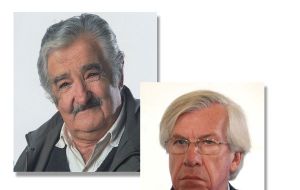MercoPress. South Atlantic News Agency
Uruguay’s presidential election next Sunday too tight to call
 Mujica-Astori inching closer but, will it be enough?
Mujica-Astori inching closer but, will it be enough? Uruguay’s coming Sunday presidential election is proving to be more nerve-racking and difficult to forecast than anticipated, with the ruling coalition just a few inches away from repeating in spite of the falling performance of the main opposition candidate.
According to the latest public opinion polls released at the main evening news in the three open television channels, the Broad Front is anywhere between one and three percentage points, (with a 2 to 3 points margin of error) from the 50% plus one votes needed to win next Sunday thus avoiding a run off at the end of November.
The vote intention polls also show that the undecided remain strong, almost 9%, --which is a rare phenomenon and further complicates forecasts— and the two junior opposition parties steadily consolidating.
The first to the aired was pollster Factum with 968 interviews collected over the weekend covering urban and rural Uruguay.
According to Factum, the incumbent presidential ticket Jose Mujica-Danilo Astori has a vote intention of 45/46%, followed by the main opposition National party with 29% and junior opposition parties, Colorado and Independents with 13% and 3% respectively.
Rather than undecided, Factum talks of “undefined” and in the bag includes undecided, blank and spoilt votes, which total 9%.
The second results to be aired were from Equipos-Mori with 1.200 interviews done over the weekend with a plus/minus error margin of 2.8 percentage points.
Equipos-Mori pointed out that the poll only refers to residents and not voters outside the country.
This is an important point because neighbouring Argentina and more precisely Buenos Aires has a significant community of Uruguayans and the administration of President Cristina Kirchner has declared next Sunday and Monday special holidays to encourage voters to cross over.
Furthermore there are special cheap fares on the ferry bridge linking Buenos Aires and Montevideo.
Five years ago, October 2004, with a similar scenario the Broad Front managed to scrape through with 50.45% of the vote, (no run-off), and voters from overseas could have supplied that 1 and fraction percentage point that made the difference.
Equipos-Mori picture shows the Broad Front with 45.5%, the National party with 27%, the Colorado party, 14.3%; Independents 2.8%; a splinter radical group 0.5% and the undecided and blank and spoilt votes, 7.4% plus 2%.
However splitting the undecided the new picture is: 48.1% for the ruling coalition; 33.3% for the National party; 15.6% Colorados and 3%, Independents.
Finally pollster Cifra vote intention picture is based on 1.209 home interviews, over last weekend with a plus/minus 2.8 percentage point margin of error.
According to Cifra the vote intention picture shows the Broad Front with 49%; the National party, 32%; Colorado party, 14% and the Independents with 2.5% and another 2.5% of blank and spoilt votes.
These percentages however include a projected discrimination of the undecided which works out as follows: Broad Front, 46% plus 3%; National, 30% plus 2%; Colorados 13% plus 1% and Independents 2% plus 0.5%.
Looking back into the percentages’ evolution of the two main contenders to search for some clues, since the beginning of the political year the Broad Front has managed to float between 42% and 46%, while the National party took off with 34%, then peaked at 37% when the primaries at the end of June but has since steadily eroded to the upper quarter of the twenties.
Three possible scenarios can be expected from these opinion polls.
First that the ruling coalition effectively manages to slip across the 50% plus one vote, meaning it will not need a run-off and also enjoy a clear majority in parliament.
Second: there’s a run off and Mujica is finally confirmed as the next Uruguayan president but will not have such a clear legislative majority which would force him to some basic agreements with the opposition on major issues of the political agenda.
Third that Lacalle wins the run-off and will have to rule with the Broad Front simple majority in Parliament that will necessarily call for political agreements.
The equilibrium point for a party or coalition to have a majority in Parliament, under the Uruguayan electoral system, is 48.5% of the vote in October.
Last but not least, political scientist Eduardo Gonzales from Cifra concluded that the overall picture shows that the ruling Broad Front catch-all coalition, which won its first election in 2004 has ceased to grow as it had done on every national election (on average five percentage points) since it was born in 1970.
“This in political terms could be indicating that the Uruguayan scenario has become politically more ‘normal’, meaning by this that the three main political forces of the country (National, Colorado and Broad Front) have now been in office and there are no expectations of a new option, such was the case in 2004” said González.




Top Comments
Disclaimer & comment rulesCommenting for this story is now closed.
If you have a Facebook account, become a fan and comment on our Facebook Page!